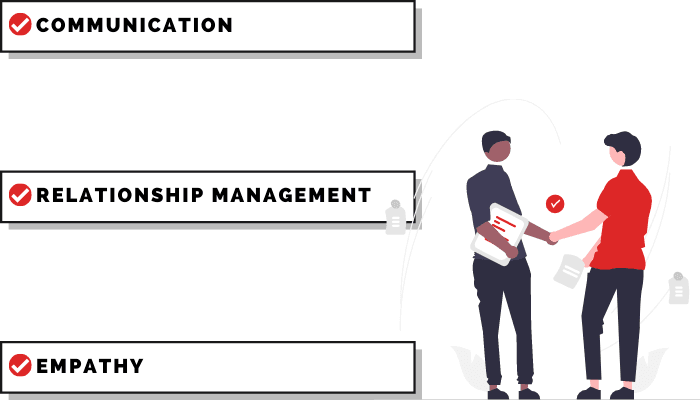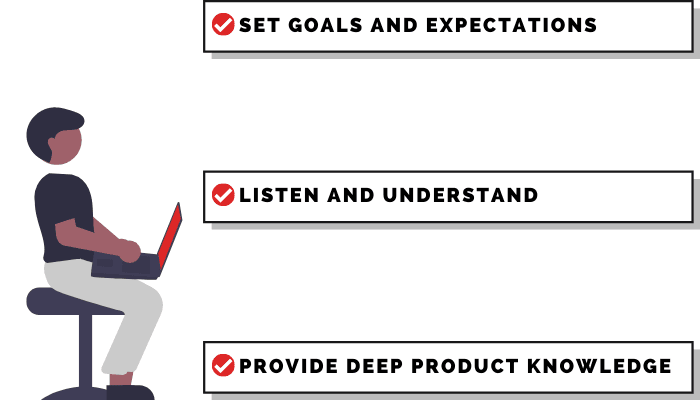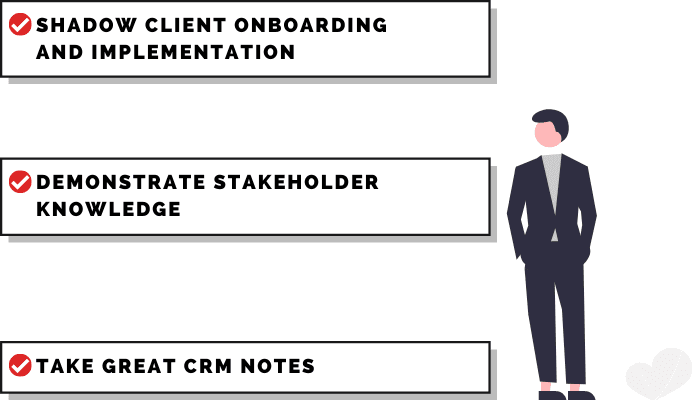Customer Success and Sales: Two Sides Of The Revenue Generating Coin
Sales and Customer Success are really two sides of the same revenue-generating coin. Learn how to transfer to customer success from sales with Uvaro!

Aug 23, 2022
No matter where you go, or who you are, there’s one universal truth: Cash is king/queen. Okay, true, sometimes "cash" is actually plastic or digital. But at home and at work, people need money in the bank to continue operating.

And this is as true for businesses as it is for you. Most software-as-a-service (SaaS) companies only really have four ways to affect their revenue position. And each of those four strategies is usually the clear responsibility of a different functional unit:
- Sales gets you more customers
- Customer Success makes sure you lose fewer customers + grow within those accounts
- Finance makes sure you spend less money
- Leadership gets money from outside sources (like investors or the government)
The skills and responsibilities of these different business units vary, but their ultimate goal is the same: Improving the company’s revenue position.
That’s why the skills you learn in sales—resiliency, empathy, drive, problem-solving, communication, negotiating, and more—are valuable in other departments. Sales skills are the skills you need for career success. Having them creates professional opportunities.
So while the benefits of working in tech sales are significant—huge earning potential, internal recognition, a large network, professional independence, flexible and energetic work environments, and more—working in tech sales doesn’t have to mean you’re a BDR or an Account Executive for the rest of your life.
Sales can be a launchpad for greater things: Just ask noted tech billionaires Mark Cuban, Larry Ellison (Oracle), Jim Balsillie (Blackberry), and Don Valentine (Sequoia), who all got their starts in sales jobs before moving on to other managerial roles. Over the course of your career, you can andshouldtry working in other job positions.
If you’re trained for sales and wondering where to go next, one obvious place to turn is Customer Success.
What Is Customer Success?
Customer Success is the art of making sure that your customers achieve their business goals. It’s one thing tosella client on the potential of your product. It’s something else entirely to ensure that you actually deliver on your promises.
Customer Success Managers (CSMs) anticipate customer questions and challenges, and proactively provide answers and solutions. Whereas support desks try to fix problems as they arise, CSMs build long-lasting relationships with clients and anticipate their needs before problems occur. Other job titles that often serve in a Customer Success role include:
- Implementation Manager
- Customer Experience Manager
- Project Manager
- Client Specialist
- Professional Services Team
No matter the job title, CSMs do what they must to make sure that the client is happy:
CSMs organize implementations, run check-up meetings, track down deliverables, visit clients, push for internal adoption, look for upsell opportunities, gather feedback, and schedule training sessions.
Like sales, Customer Success is relationship-focused. And when it’s effective, it leads to account growth, referrals, and productive long-term relationships.
For software subscriptions with higher sticker prices, having a dedicated CSM is a value-added service that may come with a hefty price tag. But smart buyers know that the investment is the best way to guarantee that a project works out.
Depending on their location and experience, Customer Success staff in North America earn $38,000 to $72,000 per year at the low end. With experience or in management roles, they can earn $100,000/year or more at the high end. They generally do not earn commissions and have only limited opportunities for variable pay.
Want to dive deeper? Read more: What is a CSM?
Why Customer Success is Important For Organizations
The Customer Success function drives client retention. And for subscription businesses, client retention is everything: Acquiring a new customer can cost up to 25 times more than it costs to retain an existing one. So even a small decrease in client churn will have a huge impact on revenue outcomes.
Sales and Marketing may bring the customers in, but Customer Success keeps them happy. Happy customers don’t shop for alternative products, and aren’t susceptible to poaching by your competitors. Better still, happy customers profit from your products. They understand the value proposition, and look for ways to improve the return on their investment.
A CSM team understands both how the client operates, and the capabilities of their products. So they can act as a trusted advisor, who can deliver results, carefully manage expectations, and stay ahead of changing requirements.
Eager customers don’t just provide recurring revenue: They provide growth opportunities, too. They buy increased product functionality, add licenses, and invest in value-added professional services. And they even pass along product development tips.
In other words: Happy customers look for more ways to spend money. And CSMs put themselves in the right position to anticipate and deliver on expansion opportunities. Sometimes, these growth opportunities aren’t even with the same client!
Here are just a few of the types of referrals that happy customers can deliver:
- Other functional departments at the same business
- Subsidiaries and parent companies
- The client’s other vendors
- The client’s own client base
- Related businesses through investors or boards of directors
- Departing employees’ next employers
- Friends, family, and professional networks
Even if happy customers aren’t spending more money or introducing you to new clients, they can still add additional value: Many businesses ask for customer references as a part of their purchasing process. And you may need more than one customer reference: Prospects often ask for clients in specific industries, in specific geographies, or of specific sizes. That’s no easy task.
A well-positioned CSM team has a deep understanding of each customer’s needs and level of satisfaction. They can identify customer champions who are best positioned to serve as references. By ensuring that clients have an outstanding experience, CSMs turn them into money-generating advocates.
What Skills Are Most Important for CSMs?

1 - Communication
Excellent communication skills (both spoken and written) are at the core of Customer Success. Good client-vendor relationships are built to last. A solid relationship can handle a whole series of mistakes. But a single error or miscommunication can shatter a relationship that’s built on a rocky foundation.
So CSMs need to say what they mean, and mean what they say. Communicate clearly, document everything, and get feedback to ensure that you’re understood. CSMs deal with a whole range of end-users who might not always have the same levels of expertise. So they need to be able to break down complex technical topics into fragments that are easy to understand for each individual listener.
Talking to upper management? Stay out of the weeds and give a birds-eye summary. But when you’re speaking to a technical team, be careful to use the correct terminology, and be humble about what youdon’tknow, too.
To achieve this, customer success managers need to be active listeners. You can’t ignore the client while you think of your next line. You need to engage honestly with their pain points, deliberate carefully, and bring forward realistic solutions.
2 - Relationship Management
Good Customer Success Managers are people persons.” Building good relationships is about more than just speaking politely or responding promptly. It means you can find genuine ways to connect with people, and build on those relationships to form lasting bonds. If your customers think that you’re their friend, you’re doing a good job. But that’s not the end of the road.
Having a single solid relationship at a client company puts you in a precarious situation. If your customer champion changes roles, leaves the company, or has to take a leave of absence, your vendor relationship is at risk. So CSMs need to forge multiple trusting relationships at each client company. This creates a moat that protects their status as a trusted partner.
3 - Empathy
Customers want to be heard, but they also want their experiences to be validated. Empathy creates trust. Good CSMs take ownership of problems, apologize for inconveniences, pursue intermediate remedies, and work towards long-term solutions.
You don’t have to solve every problem right away. But you do have to accept that for your customers, each new problem is confusing, frustrating, and deeply concerning. Even if it’s one that you may regularly encounter. After you affirm the customer’s experience, you can plan for how to mitigate the problem, and restore trust in the relationship.
How Customer Success Compares to Sales
While they often work together and speak to the same clients, Sales and Customer Success spend their time in radically different ways.
Compared to Sales, Customer Success has longer-lasting relationships, spends more time creating new client deliverables, and has less scripted communications.
Ultimately, whether you’re pursuing new prospects or engaging long-standing customers, your direct sales strategies apply to Customer Success, too:

1 - Set Goals and Expectations
When you set the agenda, and deliver on the requirements, you win the deal. But you can’t just make things up: Your agenda and value proposition needs to align with the customer’s needs.
In sales, the customer often already has these criteria clearly laid out. But for Customer Success, you’ll need to dig deeper, and document more carefully. It can take months or years to come up with a change plan.
You also have to manage your time effectively. Every client needs to feel like they're your only priority. Fast response times are critical.
2 - Listen and Understand
A good listener doesn’t just listen to reply. They also listen to understand and propose real, actionable solutions.
For sales reps, you can comfortably disqualify a prospect if you have no reasonable probability of being able to offer them a solution. Sales reps can choose how to prioritize their time, and what types of companies to prospect into.
But in Customer Success, you have to take the clients you’re assigned—good or bad. Canceling” a customer is a big deal. So you’ll have to listen a little harder, and dig a little deeper.
Great sales reps are trusted and informed partners. But for CSMs, that’s not going above and beyond: It’s the baseline.
3 - Provide Deep Product Knowledge
The more you understand your offering, the wider range of problems you can address with it. That doesn’t necessarily mean you need to know every bell and whistle. It means you need to truly understand the pain points that you can solve.
For sales reps, there’s sometimes a bit of wiggle room here. Clients who can’t find the perfect solution may be willing to accept the next best thing.
But for Customer Success, "almost solved" causes problems. It opens the door to cancellation. You need to solve the problem, help the customer work around it, or find a way to de-prioritize it. Customers have long memories. You can’t hope that they’ll forget.
How to Transfer From Sales To Customer Success
There’s no secret or guaranteed way to transition from your sales role to a job in Customer Success or any other department. But there are two necessary preconditions:
- Be successful at the job you already have.
- Ask for the new role.
Because when you’re valuable, and looking for a change, a good employer will indulge you. And if they won’t—perhaps it’s time to consider looking elsewhere. Either way, here are some additional strategies to get ahead of the curve:

1 - Shadow Client Onboarding and Implementation
Good sales reps should follow their accounts through the implementation process. But we know that you don’t always do it.
Make time for it. Show management that you care about the client’s end result, not just cashing your commission checks.
If necessary, justify your presence on implementation calls as "help with the transition", "providing background information", "showing solidarity", or "emphasizing our commitment to customer service."
Even if this doesn’t help you land a Customer Success role right away, it will help you better understand your company’s service offerings—which will make it easier for you to sell them, too.
2 - Demonstrate Stakeholder Knowledge
Customer Success is an exercise in people management. Can you get a large group of people with different interests to commit to a single direction?
Prove it by demonstrating deep stakeholder knowledge as a part of your sales process. Ask about project sponsorship, potential advocates and opponents, primary users, and budget approvers. Ask until you get the answer, and then flag every ask and every answer in your call notes.
When you interview for a transfer to Customer Success, you can reference your call stats as evidence of your fit for the job. They're proof that you understand the stakeholders, can root out potential opponents, and can keep everyone aligned on the project.
3 - Take Great CRM Notes
For sales reps, closing deals is exactly 50% of your job. The other half is documentation. When you’re chasing commissions, writing detailed notes can feel like a waste of time. But taking great notes provides evidence that you do great work.
Sales reps can and do get lucky (and unlucky, too!). A suddenly surging territory or unforeseen market shift can affect your performance metrics dramatically. But documentation will prove that you capitalized on the opportunity that came to you (or that the failure wasn’t your fault).
This documentation is also the evidence you need to get the job transfers and promotions that you want. So don’t just take notes for the sake of taking notes. Write notes thatprovethat you understand every client’s business goals.
Discover Your Tech Sales Career Path
Transitioning away from a bag-carrying” sales job doesn’t need to be hard or stressful. The path is well-worn, from sales to customer success, to marketing, to operations, and even to product and to finance.
The skills you develop during your sales career apply to plenty of other job paths. Sales skills are skills that are in demand.
If you’re struggling with where to go in your sales career or could benefit from help in your job transition, talk to a Uvaro Career Coach today.






